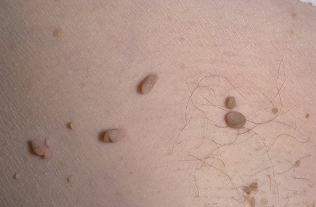Papilloma is a skin and mucous membrane lesion caused by human papilloma virus.
Causative agents - Viruses of the genus Papilloma virus. More than 60 variants are currently known, 32 of which are considered to cause disease.
Transmission routes - contact (through skin microtrauma), genital, perinatal (at birth).
Symptoms of papillomas

- Cutaneous papillomas (warts).
Most often on the hands, less often on other parts of the body. Localized lesions are common in children and adolescents. Wart lesions may be common in immunocompromised patients. The incubation period is 1-6 months. The maximum virus content in affected tissues is noted 6 months after infection. - Coarse (simple) papillomas.
The causative agent is human papillomavirus (HPV). This shape is characterized by stiff protrusions with a rough surface of 1 mm or more in diameter, which tend to coalesce. Vulgar papillomas usually cover a large area. They can appear anywhere, but are more often found on the palms and behind the fingers, in children - on the knees. A single papilloma can exist for several months or even years, practically unchanged, but the rapid spread of the process is also possible. There are isolated cases of papilloma degeneration that turned into a tumor. Immunodeficiency states contribute to the spread of the process. - Plantar papillomas.
The causative agent is HPV-1 (deep form), HPV-2 (mosaic warts) and HPV-4 (minor lesions). The process begins with the appearance of a small shiny bump that acquires the characteristics of a typical papilloma surrounded by a protruding rim. Sometimes, around a papilloma, multiple formations of girls appear, resembling blisters - mosaic warts.
Plantar papillomas can be painful and make walking difficult. The duration of their existence is different. In some cases, especially in children, it is possible for any number of papillomas to disappear spontaneously. This form of the disease is often confused with calluses that appear on the toes or between the fingers. Unlike papillomas, corns have a smooth surface with leather pattern. - Flat papillomas.
Its causative agents are HPV-3 and HPV-10. They are represented by flat bumps of normal skin color (light yellow or slightly colored). They can be round or polygonal in shape. The occurrence of flat papillomas, especially in children, is usually accompanied by itching, inflammation of the affected area, redness, pain. - Filiform papillomas.
50% of the population over the age of 50 are more common in the armpits, groin, neck and around the eyes. The process begins with the appearance of small yellowish or slightly colored cones, then expand and turn into dense elastic formations elongated to 5-6 mm in size. Papillomas can become inflamed in places of possible trauma. They do not disappear spontaneously. - Local epithelial hyperplasia (Beck disease).
The causative agents are human papilloma viruses 13 and 32. The disease was first described in the Indians. Small joints in mouth, tongue and lip mucosa are seen as papillary protrusions. - Genital warts.
The causative agents of genital warts are human papilloma viruses with low (6, 11), medium (31, 33, 35) and high (16, 18) oncological risks. Viruses are sexually transmitted. The incubation period lasts from a few weeks to months. In some cases the lesions are minimal, often unnoticeable. Infected cells are prone to malignant degeneration. In most cases, immunodeficiency states are accompanied by a long and widespread process.
Cervical cancer is most often diagnosed in women with genital warts. In most cases, the viral genome is detected by DNA hybridization, despite the patients' age. The causative agent is HPV-18. - Juvenile papillomatosis of the larynx.
The causative agents are HPV-6 and HPV-11. They are rarely registered. In most cases, papillomatosis is detected in children under 5 years of age infected in the mother's birth canal. The characteristic growths in the vocal cords cause speech difficulties and impaired air circulation in the upper respiratory tract.
Treatment of papillomas
The same symptoms may be symptoms of different diseases and the disease may not progress according to the textbook. Do not try to heal yourself - consult your doctor.
Currently, there is no unified international standard for the treatment of papillomas. Among the official treatment guidelines so far
- cytostatics (antineoplastic drugs),
- cryo laser,
- electro destruction.
However, they are not always effective and relapses accompany.
Other treatments for papillomas:
- For cutaneous and coarse (simple) papillomas - surgical removal (cryodestruction, laser removal with immune correction).
- Plantar - for cryodestruction, laser and / or diathermocoagulation.
- Mosaic papillomas are the most difficult to treat. Symptoms of inflammation are seen when they disappear, especially in children.
- For straight forms - immune corrected cryotherapy.
- Filiform - for diathermocoagulation.
- Immune corrected cryotherapy for local epithelial hyperplasia.
- In case of wart cutaneous dysplasia, cryotherapy or diathermocoagulation followed by immune correction.
- For genital warts - removal of warts by cryo therapy, laser excision or diathermocoagulation and mandatory correction of the immune system.
Treatment of genital papillomas can be difficult with other genital infections (chlamydia, bacterial vaginosis, herpes, CMV infection, etc. ). In these cases, treatment is carried out in parallel.














































































